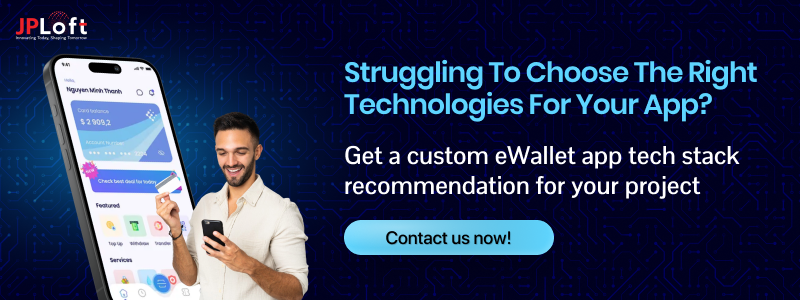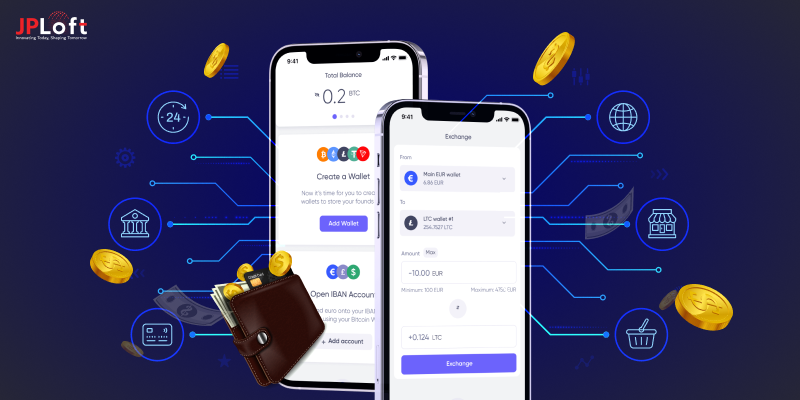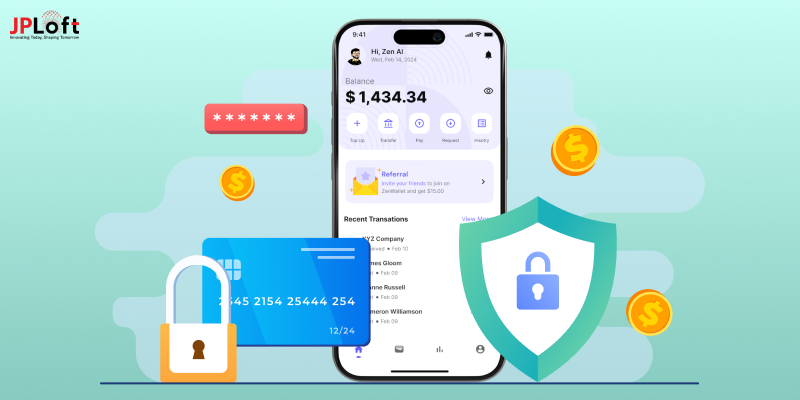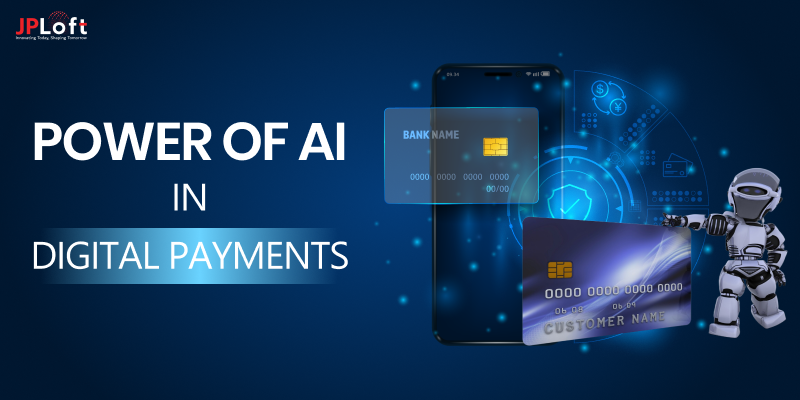Building an eWallet app is like assembling a high-tech puzzle – every piece needs to fit perfectly to create a seamless, secure, and reliable experience.
The eWallet app tech stack you choose is the foundation that holds everything together. From smooth user interfaces to rock-solid backend security, the right tools can make all the difference.
But with so many options available, how do you pick the perfect digital wallet app tech stack for your app? Don't worry, we've got you covered!
In this guide, we'll break down the must-have technologies and show you exactly how to choose the right eWallet app tech stack to make your digital wallet app stand out in the crowded market.
Ready to find out? Let's get started!
Understanding the eWallet App Tech Stack
Building an eWallet app isn't just about making payments more straightforward – it's about creating a digital wallet that's secure, fast, and super user-friendly!
This is where "App Stack" plays its part.
Think of the eWallet app tech stack as the secret element behind the magic. It's a blend of remarkable technologies working together to make every swipe, tap, and transfer smooth.
On the frontend, frameworks like React or Angular create a sleek and intuitive interface. At the same time, powerful backend technologies like Node.js or Ruby on Rails handle the heavy lifting behind the scenes, making sure your transactions are quick and secure.
Then there are the databases – MySQL or MongoDB – that safely store all your data, while APIs and payment gateways like Stripe or PayPal connect you to the world of digital payments.
Oh, and let's not forget the all-important security protocols, ensuring that your money is always safe and sound.
With the right tech stack, you can build an eWallet app that users will love and trust!
eWallet Market App Stats
The eWallet market has witnessed remarkable growth, reflecting the increasing adoption of digital payment solutions worldwide.
Consider the following statistics:
-
- Global Market Value: The global mobile wallet market was valued at approximately $7.42 billion in 2022 and is projected to expand at a compound annual growth rate (CAGR) of 28.3% from 2023 to 2030, potentially reaching $51.53 billion by 2030.
- User Adoption: In the United States, 53% of consumers used digital wallets more frequently than traditional payment methods in 2023, with 64% using them at least as often.
- Projected Growth: Juniper Research forecasts that the number of digital wallet users will grow from 3.4 billion in 2022 to 5.2 billion globally by 2026, indicating a growth rate of 53%.
These statistics show the vital role eWallets play in the modern financial landscape and highlight the importance of selecting an appropriate tech stack for eWallet apps to meet the changing demands of users.
Importance of eWallet App Tech Stack
The eWallet app tech stack is the backbone of a digital wallet app, influencing everything from security to user experience.
A well-chosen tech stack ensures that your app is scalable, secure, and able to handle user demands.
Here's why it's essential to choose the right one:
1. Security First
A solid eWallet app tech stack prioritises security, protecting user data from fraud and cyber threats.
Technologies like encryption, two-factor authentication, and tokenization safeguard financial transactions, ensuring that sensitive information is never compromised.
With financial apps being prime targets for hackers, incorporating the best security practices is essential for user trust and regulatory compliance.
2. Seamless User Experience
The mobile wallet tech stack plays a pivotal role in delivering a seamless, intuitive user experience.
Frontend frameworks like React or Angular allow for smooth interfaces that keep users engaged, while backend technologies ensure fast transaction processing.
A well-optimized tech stack makes the difference between an app users return to and one they abandon due to frustrating interactions.
3. Scalability for Growth
As the number of users and transactions grows, your digital wallet tech stack needs to scale without breaking down.
A scalable tech stack, using cloud-based solutions or microservices, enables your app to handle more data and traffic efficiently.
This scalability ensures that your app can grow alongside your business without sacrificing performance or reliability.
4. Faster Transactions
In the ever-changing world of mobile payments, speed is everything.
A well-crafted eWallet app tech stack ensures transactions happen quickly, with minimal delay.
Technologies like Node.js or Redis can optimize data flow, reducing the time users spend waiting for transactions to be processed.
Fast transactions not only enhance user satisfaction but also position your app as a reliable payment solution.
5. Integration with Payment Gateways
Integrating payment gateways like PayPal, Stripe, or Apple Pay smoothly is essential for a digital wallet app.
A well-designed tech stack of eWallet apps simplifies these integrations, making it easier to accept payments, issue refunds, and support multiple payment methods.
This connectivity ensures your app meets the diverse needs of users, enabling them to pay and transfer funds seamlessly.
6. Cross-Platform Compatibility
The mobile wallet tech stack should allow your app to perform consistently across various devices and platforms, whether iOS or Android.
Cross-platform frameworks like Flutter or React Native help ensure that the app delivers a similar user experience on both platforms without duplicating effort or resources.
This broader reach increases user adoption and boosts app downloads.
7. Regulatory Compliance
Ensuring that your eWallet app tech stack complies with regulations such as GDPR, PCI-DSS, or PSD2 is critical.
A tech stack built with compliance in mind ensures that your app follows legal guidelines and adheres to financial industry standards.
This reduces the risk of fines and provides users with peace of mind, knowing their data and transactions are safe.
Key Component of Digital Wallet App Tech Stack
Building a protected, flexible, and feature-rich eWallet app requires a well-structured and robust technology stack that ensures seamless financial transactions, strong security, and a smooth user experience.
However, challenges in eWallet app development, such as security vulnerabilities, regulatory compliance, and seamless third-party integrations, make it crucial to choose the right technologies.
With the growing demand for digital payments, businesses need to integrate advanced technologies that enhance app performance, provide high-level encryption, and comply with industry regulations.
From user authentication and real-time payment processing to fraud prevention and third-party integrations, every component plays a critical role in the app's success.
A well-optimized tech stack not only helps overcome issues in eWallet apps but also enhances scalability to handle high user volumes efficiently.
Below are the key components of an eWallet app tech stack that ensure a high-performance, secure, and future-ready digital payment solution.
|
Component |
Technologies & Tools |
|
Frontend Technologies |
Native: Swift (iOS), Kotlin (Android) Cross-Platform: React Native, Flutter |
|
Backend Technologies |
Frameworks: Node.js, Django, Spring Boot Scalability: Microservices, Load Balancing |
|
Database Management |
SQL: PostgreSQL, MySQL NoSQL: MongoDB, Firebase |
|
Payment Gateway & API Integrations |
Gateways: Stripe, PayPal, Razorpay Banking & UPI: Open Banking APIs, Blockchain Payments |
|
Security & Compliance |
Encryption & Compliance: PCI DSS, AES-256 Encryption Authentication: Biometric, 2FA Fraud Prevention: AI-Powered Fraud Detection |
|
Cloud Infrastructure & Hosting |
Cloud Providers: AWS, Google Cloud, Azure Hosting: Serverless Architecture, Kubernetes |
|
Third-Party Services & SDKs |
KYC & AML: Onfido, Trulioo Messaging & Notifications: Twilio, Firebase Cloud Messaging |
|
Blockchain & DeFi Integration (Optional) |
Platforms: Ethereum, Hyperledger Smart Contracts: Secure Transactions |
|
Performance Optimization & Testing |
Optimization: Redis (Caching), CDN (Faster Content Delivery) Testing: Security Testing, Load Testing |
Common eWallet App Tech Stack: The Secret Behind Digital Transactions
Ever wondered how your favorite eWallet app processes transactions within seconds, ensures airtight security, and never seems to lag, no matter how many users are online?
The magic lies in its digital wallet tech stack, a powerful combination of technologies working behind the scenes to deliver seamless, secure, and lightning-fast transactions.
Developing a mobile wallet app isn't just about adding a "Send Money" button- it requires a well-optimized tech stack that ensures top-notch security, high-speed performance, and seamless integration with banking systems.
So, let's break down the essential components of a guide to eWallet app tech stack in a fun, engaging way!
1] Frontend Technologies
The frontend is what users see, tap, and interact with daily.
A smooth, intuitive, and visually appealing UI/UX, backed by a well-structured app prototype & wireframe, makes an eWallet app user-friendly and engaging.
If your app looks outdated or lags, users will uninstall it in seconds!
► Native vs. Cross-Platform Development
Choosing the proper frontend framework depends on performance, cost, and scalability.
Native Development (Best for Performance)
-
- iOS Apps: Swift (Apple's powerful and optimized language)
- Android Apps: Kotlin (Fast, reliable, and Google-backed)
Cross-Platform Development (Faster & Cost-Effective)
-
- React Native (Developed by Facebook and used by Instagram, Facebook, and Shopify!)
- Flutter (Google's UI toolkit for stunning animations and seamless UI)
Pro Tip: Want a high-performance mobile wallet app tech stack? Go native. Need a faster launch with a single codebase? Go cross-platform!
2] Backend Technologies
Your backend is the foundation - it handles transactions, processes requests, and ensures security. Without a strong backend, an eWallet app would be nothing more than a flashy interface.
Popular Backend Frameworks
-
- Node.js: Fast, real-time, and event-driven (best for high-transaction apps)
- Django (Python): Secure and scalable (trusted by fintech startups)
- Spring Boot (Java): Enterprise-grade reliability (used by banks and financial institutions)
Pro Tip: A robust digital wallet tech stack ensures instant transactions, fraud prevention, and support for millions of users simultaneously!
3] Database Management
Every transaction, user profile, payment history, and saved card details must be securely stored in a high-performance database.
► SQL vs. NoSQL: Which One to Choose?
SQL Databases (Structured & Reliable for Finance Apps)
-
- PostgreSQL: Secure and supports complex queries
- MySQL: Reliable and widely used
NoSQL Databases (Flexible & High-Speed for Large-Scale Apps)
-
- MongoDB: Perfect for handling unstructured data
- Firebase: Great for real-time updates
Pro Tip: A fast, scalable, and secure database is the foundation of any successful mobile wallet app tech stack- choose wisely!
4] Payment Gateway & API Integrations
No eWallet app is complete without a secure and reliable payment gateway. Users want instant transactions-so, so choosing the proper integration is key!
Popular Payment Gateways
-
- Stripe: Best for customizable payment flows.
- PayPal: Trusted worldwide
- Razorpay: Ideal for India-based transactions
Banking & UPI Integrations
-
- Open Banking APIs: Allow users to link bank accounts directly.
- Blockchain Payments: Secure, decentralized transactions
Pro Tip: The future of eWallet apps is blockchain, open banking, and instant cross-border payments- stay ahead of the curve!
5] Security & Compliance
Money is involved, so digital wallet security is non-negotiable. Users must trust your app to protect their sensitive information.
Essential Security Features:
-
- PCI DSS Compliance (Required for secure card payments)
- AES-256 Encryption (Bank-grade encryption)
- Two-Factor Authentication (2FA) (Extra layer of security)
- Biometric Authentication (Fingerprint & Face ID login)
Pro Tip: AI-powered fraud detection tools can analyze transaction patterns to detect suspicious activity in real-time - this is where AI in digital wallets is revolutionizing security!
6] Cloud Infrastructure & Hosting
Your eWallet app needs to be fast, scalable, and always online. This is where cloud hosting comes in.
Cloud Hosting Providers:
-
- AWS (Amazon Web Services): The fintech industry's top choice
- Google Cloud: Secure and AI-powered
- Microsoft Azure: Great for enterprises
Hosting Options:
-
- Serverless Architecture (Scales automatically, saving costs)
- Kubernetes (For Containerization) (Keeps services running efficiently)
Pro Tip: A slow eWallet app can lose 40% of users-speed and uptime are everything!
7] Blockchain for Transparency
Blockchain technology is revolutionizing eWallet apps by ensuring secure, tamper-proof, and transparent transactions. Unlike traditional banking systems, blockchain removes intermediaries, reducing costs and increasing transaction speed.
Why Use Blockchain:
-
- Decentralization: No single entity controls the data, making it more secure.
- Immutable Ledger: Transactions cannot be altered, reducing fraud.
- Smart Contracts: Automate transactions and agreements without intermediaries.
- Cross-Border Transactions: Faster and cheaper global payments.
Popular Blockchain Technologies for eWallets:
-
- Ethereum: Best for smart contract-based payments.
- Hyperledger Fabric: Enterprise-grade blockchain solution.
- Solana: High-speed and low-cost transactions.
Pro Tip: The future of fintech is decentralized. Implementing blockchain in your eWallet app can enhance security, transparency, and user trust. Some of the top eWallet apps are already integrating blockchain for secure and seamless transactions!
8] AI & Analytics
AI-driven analytics empower eWallet apps with personalized recommendations, fraud detection, and predictive insights.
AI not only enhances user experience but also strengthens security and operational efficiency.
How AI Elevates eWallet Apps:
-
- Fraud Detection: AI detects unusual spending patterns and flags suspicious transactions.
- Personalized Spending Insights: Users get custom reports on their expenses.
- AI Chatbots & Virtual Assistants: Handle user queries 24/7.
- Credit Scoring & Risk Analysis: AI analyzes transaction history to offer credit-based services.
AI-Powered Tools for eWallet Apps:
-
- TensorFlow: Machine learning for fraud prevention.
- IBM Watson: AI-powered customer support and analytics.
- Google AI: Predictive analytics for user behavior.
Pro Tip: AI is not just an add-on- it's the key to a brighter, safer, and more engaging eWallet experience. Keeping up with trends in eWallet apps, such as AI-driven security and analytics, ensures your app stays ahead of the competition!
With this being clear, let's find out how to choose the right tech stack for your digital wallet app so that you stay ahead of the curve, not just keep up.
How to Choose the Right Tech Stack for an eWallet App?
Choosing the right technology stack for a digital wallet app is crucial for performance, security, and scalability.
A well-structured tech stack ensures smooth transactions, fast load times, and a seamless user experience.
Here are some key tips to help you make the right choice:
1. Prioritize Security & Compliance
An eWallet app handles sensitive financial data, so security should be your top priority.
Look for technologies that support AES-256 encryption, PCI DSS compliance, and two-factor authentication. AI-powered fraud detection can add an extra layer of protection.
2. Choose the Right Frontend & Backend Technologies
For a smooth user experience, pick a frontend framework that offers fast performance and responsiveness. Swift and Kotlin are remarkable for native apps, while React Native and Flutter work well for cross-platform solutions.
On the backend, Node.js, Django, and Spring Boot provide reliability and scalability for handling transactions efficiently.
3. Select a Reliable Database
A fast and secure database is essential for managing user accounts, transaction history, and payment details. SQL databases like PostgreSQL and MySQL ensure data consistency, while NoSQL options like MongoDB and Firebase offer scalability.
The right choice depends on your app's structure and expected user base.
4. Ensure Smooth Payment Gateway & API Integrations
Your eWallet app should support multiple payment methods, including credit cards, UPI, and even blockchain transactions. Integrating APIs from Stripe, PayPal, or Razorpay ensures seamless transactions.
Open banking APIs can also enhance your app's functionality by enabling direct bank integrations.
5. Focus on Scalability with Cloud Hosting
Your app should be able to handle increased traffic without slowing down.
Opt for cloud solutions like AWS, Google Cloud, or Microsoft Azure to ensure high uptime and reliability.
Serverless architecture and Kubernetes can help your app scale efficiently as your user base grows.
6. Consider Development Speed & Cost
Balancing cost and performance is key when selecting a standard technology stack for an eWallet app.
If you need a fast launch, cross-platform frameworks like React Native reduce development time.
However, for the best performance and security, native development may be a better investment.
Understanding the cost to develop an eWallet app helps you choose the right tech stack while staying within budget.
How JPLoft Ensures the Perfect Tech Stack for Your eWallet App Success?
Choosing the right tech stack can make or break your eWallet app's success!
At JPLoft, we don't just build apps- we craft seamless, secure, and scalable digital wallet solutions tailored to your business needs.
As a top-notch eWallet app development company, we analyze your app's requirements, user base, and future scalability to recommend the best frontend, backend, database, and security technologies.
Whether you need a high-performance native app or a cost-effective cross-platform solution, our expert team ensures you get the perfect balance of speed, security, and innovation.
Let's build a future-ready eWallet app that stands out in the market!
Conclusion
Choosing the right eWallet app tech stack is the foundation of a successful digital payment solution.
The right combination of frontend, backend, database, security, and cloud infrastructure ensures that your app is fast, secure, and scalable.
With the digital payments industry evolving rapidly, integrating AI, blockchain, and open banking APIs can future-proof your app and set it apart from the competition.
In case you're a startup or an enterprise, investing in the right tech stack today ensures a seamless user experience and long-term success.
Ready to build the ultimate eWallet app? Let's make it happen!
FAQs
Swift/Kotlin for native apps, React Native/Flutter for cross-platform, Node.js/Django/Spring Boot for backend, MySQL/MongoDB for databases, Stripe/PayPal for payments, and AES encryption with 2FA for security.
User-friendly UI, secure backend, payment gateway integration, encrypted transactions, and reliable database management for storing user and transaction data.
Blockchain ensures tamper-proof, decentralized, and transparent transactions, reducing fraud risks while enabling fast, low-cost payments with smart contracts.
PostgreSQL/MySQL for structured data, MongoDB/Firebase for real-time scalability, depending on app needs.
The development timeline depends on the app's complexity and features. A basic eWallet app may take 3–6 months, while an advanced app with AI, blockchain, and multi-platform support can take 9–12 months or more.














Share this blog